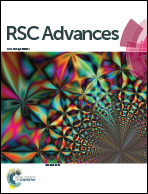Theoretical study on the influence of a secondary metal on the Cu(110) surface in the presence of H2O for methanol decomposition†
Abstract
Density functional theory calculations with the continuum solvation slab model are performed to investigate the effect of metal dopants on the Cu(110) surface in the presence of H2O for the methanol decomposition. The sequential dehydrogenation of methanol (CH3OH → CH3O → CH2O → CHO → CO) is studied in the present work. The results show that the introduction of different metals (Pt, Pd, Ni, Mn) on the H2O/Cu(110) surface notably influence the adsorption configurations and adsorption energies of all adsorbates, and remarkably affect the reaction energies and activation energies of the elementary steps. The Pt, Pd and Ni doped H2O/Cu(110) surfaces are able to promote hydrogen production from methanol decomposition, but Mn doped H2O/Cu(110) surfaces are unfavorable for the reaction. The activity of methanol decomposition decreases as follows: Pd–H2O/Cu(110) > Pt–H2O/Cu(110) > Ni–H2O/Cu(110) > H2O/Cu(110) > Mn–H2O/Cu(110). Finally, the Brønsted–Evans–Polanyi plot for the main methanol dissociation steps on the metal doped and un-doped H2O/Cu(110) surfaces are identified, and a linear relationship between the reaction energies and transition state energies is obtained.


 Please wait while we load your content...
Please wait while we load your content...